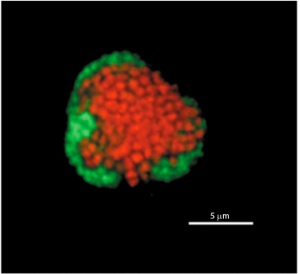In session 19i: Bioenergetics in Geochemical Modeling today, Marc Alperin put forward the provocative idea that methane-cycling ANME archaea in consortia with sulfate-reducing bacteria are not oxidizing methane, as commonly presumed, but producing it.
The hypothesis comes from modeling the consortia in a diffusion-reaction model. When archaea (red cells in the figure) are modeled as methane-oxidizers, predicted rates of methane oxidation and sulfate reduction are orders of magnitude short of what is actually observed. However, if the model allows the archaea to produce methane instead, predicted rates of sulfate reduction are close to observed rates. The new model predicts that sulfate-reducing bacteria (green in the figure) will even have higher energy yields. They do even better by sharing H2 with methanogens.
Talks that challenge dogma are always attention-getting and provoke new thinking. Now the onus is on everyone to go out and test the new model – and to determine how the methane is being oxidized if not by ‘reverse’ methanogenesis.
